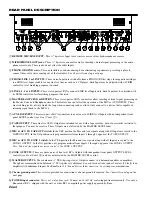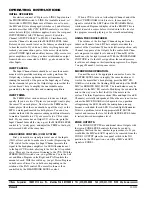
Manual-6
OPERATING INSTRUCTIONS
INITIAL OPERATION
For starters, connect a CD player to LINE 1 Input and set
the PHONO/LINE switch to LINE. If a turntable is used, set
this switch to PHONO. Make sure all faders are set to zero,
the MIC and EQ are disengaged (switches
out
) and all rotary
controls are either fully CCW (LEVEL controls) or in their
center detents (EQs), whichever applies. Leave the rear panel
INPUT TRIMS at full CW (factory preset). Switch the
Channel A INPUT SELECT to PH/LN 1. Simultaneously
raise the Channel A fader and the MASTER LEVEL fader.
Before you cover much travel on the faders you should begin
to hear the results. If you do not, shut everything down and
recheck your connections, power to the mixer (look for the
yellow POWER light) and ancillary devices (EQs, crossovers,
power amplifiers, etc.) Once you have established an output
from whatever is connected to LINE 1, go ahead and try the
other Inputs.
INPUT FADERS
The Input Channel faders should be set near their maxi-
mum levels to preclude requiring excessive gain from the
Output stage. Achieve optimum noise performance by
running the majority of the gain on the Input stages. Taking
the least amount of gain on the Output stage ensures that the
system doesn’t have to amplify the unavoidable noise
generated by the input buffers and summing amplifiers.
INPUT TRIMS
The TRIMS allow various devices to drive each Input
equally. If you have two CD players, you might want to play
the same CD on each player. Now lower the TRIM on the
louder player (the other one should be up all the way) so the
MP 22z meter peaks match for both players. You can use a
similar method with the same recording on different formats
to match a turntable to a CD, or a cassette to a CD or video
deck. If your source has an Output VU of its own, push the
Input Channel fader all the way up, set the MASTER LEVEL
control to “6” (unity gain), and adjust the TRIM so that both
meters reach 0 dB at the same time.
HEADPHONE CONTROL (CUE) SYSTEM
First, you must have signal present at one of the Inputs.
(Well, at least you do to make sure it works.) Depressing the
CUE switch for the respective Input Channel presents this
signal to the headphone amplifier. An LED illuminates next
to the Input CUE switch, attesting to the fact that it is pushed
down
. There are two choices of listening to the CUE. With the
STEREO/MONO switch
down
, you get Mono Cue in the Left
ear and Mono Program in the Right, and PAN controls the
amount of each. With this switch
up
, you get Stereo Program
in both ears or Stereo Cue in both ears, depending on the
rotation of the PAN control. The overall volume is then
controlled by the HEADPHONE LEVEL control.
When a CUE is active at either Input Channel, and if the
Meter CUE/PROGAM switch is
down
, the monoed Cue
signal is routed to the LEFT side of the PEAK dBu Meter,
while monoed Program is displayed on the RIGHT. This is
useful to match a source before it is faded in to the level of
the program currently playing, or for visual beat matching.
USING THE CROSSFADER
The volume of the two Input Channels begins from the
faders on Channels A and B. Their outputs are under the
control of the Crossfader. When in its left-most position, only
Channel A appears at the Outputs. In the center, both Chan-
nels are present in equal levels, and only Channel B will be
heard once the far right is reached. With the CROSSFADER
CONTOUR set to the full ccw position, the sound pressure
level does not change as this transition progresses. See Figure
1 on page Manual-1 for response curves.
MICROPHONE OPERATION.
Connect the mic to the appropriate connector. Leave the
MASTER LEVEL fader in roughly the same location as it
was for the music that’s been playing, press the MIC EN-
GAGE switch (notice the flashing LED) and adjust the MAIN
MIC (or REMOTE MIC) LEVEL. The tonal balance may be
adjusted via the MIC EQ controls. Modifying the sound of the
mic in this way won’t affect the EQ of the music in the
system. The three Equalizer sections (Mic and Input A and B
Channels) are totally independent. When the mic is not in use,
release the MIC ENGAGE switch again to its
up
position,
extinguishing the LED. Should the microphone preamp
become overloaded, the red LED Overload light illuminates.
If this is a problem, lower the appropriate MIC LEVEL
control and increase the level of the MASTER LEVEL fader
to restore desired microphone level.
ZONE OUTPUTS
The ZONE OUTPUTS are additional stereo Outputs with
their own ZONE LEVEL controls that can be routed to
amplifers that feed the bar, another tape recorder, etc. If you
would like the MIC and AUX signals to be removed from the
ZONE 1 OUTPUT place the rear panel switch in the NO
position. In the YES position, you will get MIC and AUX
signals in ZONE 1.
©Rane Corporation 10802 47th Ave. W., Mukilteo WA 98275-5098 TEL (425)355-6000 FAX (425)347-7757 WEB http://www.rane.com
103293
























